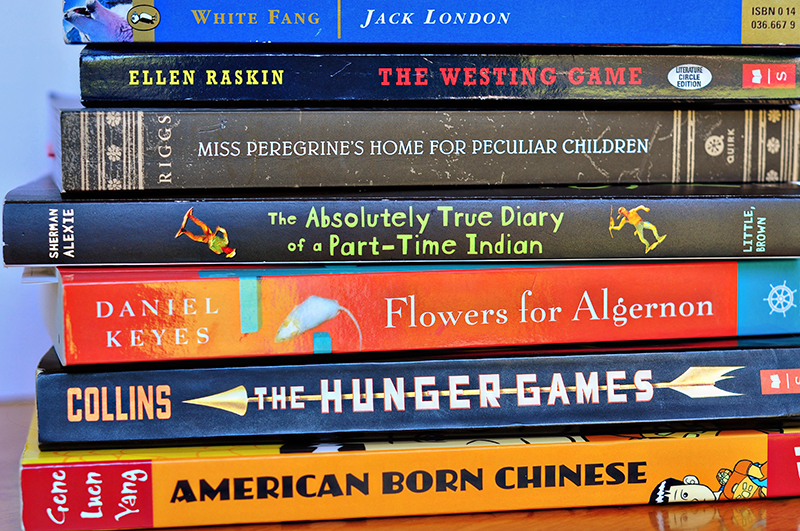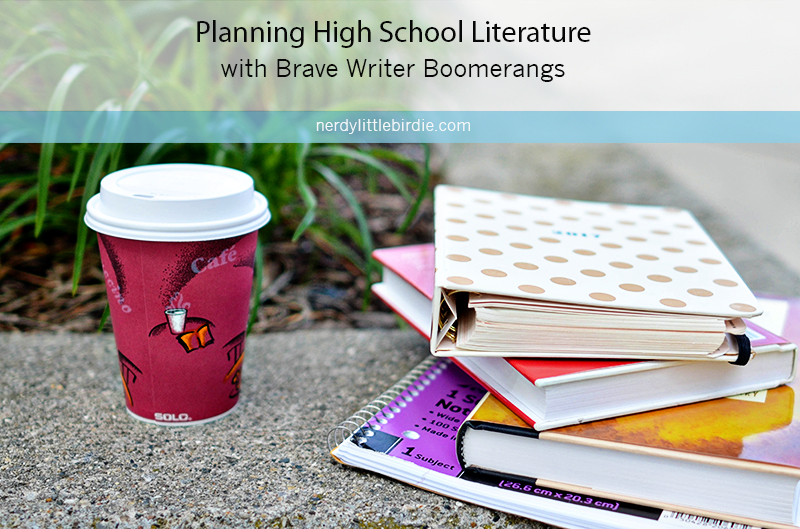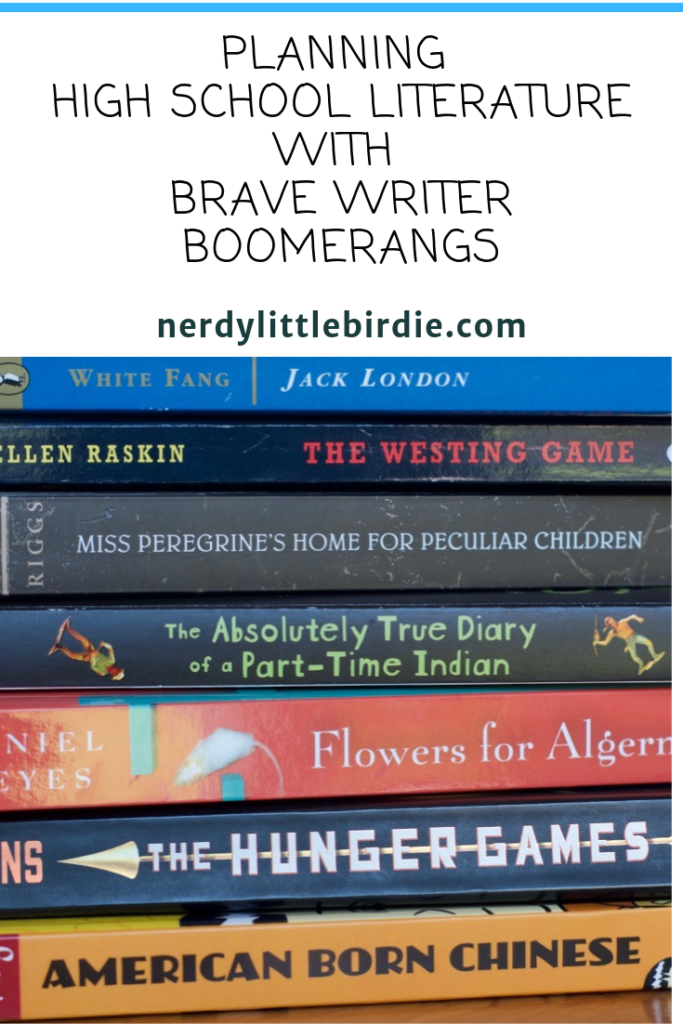UPDATED JUNE 2019
When my boys were younger, my approach to literature was tied to a complex pedagogy called Let’s Just Read. I’m sure you’ve heard of it. It’s where you find books you’re interested in and you read them. Difficult to implement. Took years of practice!
But as my boys approached high school, I naturally began to feel pressure to do more than Let’s Just Read. Sure, it worked great for growing a love of books, but what about the new mission of preparing them for Lit 101 in college?
I floundered for a while, trying to find a literature program that fit. We’re secular homeschoolers so that alone shortened our list of potential homeschool curriculum programs. Even if I considered secularizing a religious-based curriculum, many of the literature programs were heavy on the classics. While I’m all about some classics, I’m not about all classics. I fall asleep just thinking about it. There are too many wonderful books out there to limit our exposure to one genre.
Books, Boomerangs and Brownies
I finally found Brave Writer Boomerangs. It had the variety I was looking for, it’s nonsectarian, and its approach to English just felt right. Not to mention Brave Writer encourages eating brownies in your school day. An English program after both my heart and my waistline.
Even though the English curriculum stars finally aligned, I admit I still struggled my first year with how to teach efficiently with Boomerangs. I like knowing the Big Picture, but I also like a more detailed road map of how to get there. Look, I’m a solid Type A person. It’s how I work.
The details are in the Boomerang guide, but I want to know where I’m going before I dive in. Symbolism? Figurative language? Plot? Character analysis? I want an overall “outline” before starting. It helps me see (in my mind) the information I’m working with, and then I can play around and adapt plans for my kids.
Below is my Boomerang planning process. I hope you’ve sharpen those No. 2 pencils because I’m about to get wordy.
Step 1: Read through the Boomerang
To plan a new Boomerang, I grab a sheet of notebook paper and read through the entire guide, jotting down the different concepts covered over the whole thing. This is a messy first step. I’m just jotting down all the concepts that show up. I look over those concepts and circle the ones I want to focus on with this particular book. For example, I chose symbolism and theme development in Flowers for Algernon.
Then I do a second closer reading of each week and create more organized notes. At this point, I’m noting three different aspects for each week in the guide:
- Grammar. What is covered with this week? Have we mastered it already? If not, is it brand new or just review time? Do I need to pull a grammar book?
- Writer’s craft & literary elements. What’s being highlighted this week about the author’s style? I jot down what literary element(s) (tone, point of view, foreshadowing, theme, etc.) is being covered each week. Is there anything in my Annotating Literary Elements guide I want to pull in and use?
- Freewrite. If I have a specific idea for the week’s freewrite and resources to pull in for support, I jot it down.
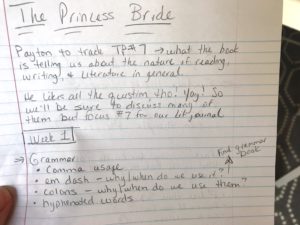 I don’t try to teach ALL THE THINGS with one book. No beating a book into the ground allowed here. I look through my list and select a few concepts to focus on. We’ll still do a quick cover of the other aspects found in the Boomerang, but I usually home in on a focus.
I don’t try to teach ALL THE THINGS with one book. No beating a book into the ground allowed here. I look through my list and select a few concepts to focus on. We’ll still do a quick cover of the other aspects found in the Boomerang, but I usually home in on a focus.
I may decide that I need to coach the characteristics of symbolism & how to recognize it, plus how to determine theme with the help of annotation. The next book may be character development. Like that. 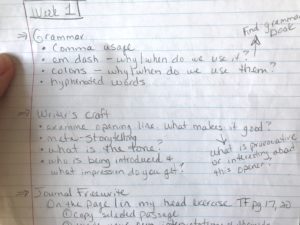
Once my focus is set, I pull any additional resources I might need, like Annotating Literary Elements, and see what I can use to cover those goals. I note what resource and page number I need each week. (“TF” pg 17, 20 in my freewrite section is Trees in the Forest, the exercise found on pg 17 & 20.)
Step 2: Give your teen the Think Piece question list
Before we start reading the book, I have my teens read over the Think Piece questions in the guide. If there’s one that grabs their interest, I make a note and we track it over the course of the book. Almost as if the Think Piece is a thesis question for a paper, and we’re training how to gather information for it. Because we are.
Step 3: Start reading. With a highlighter in hand
I then send my kids off to start reading the book. BUT! They must annotate the book as they read. I tell them to look for important events, lines that jump out at them, ones that make them pause as they read. Highlight those. If they happen to pick a Think Piece question to track, I tell them to watch for things related to that too.
That’s all. I’m not about overkilling the annotation. Too much annotation interrupts the flow of reading and makes it less enjoyable. You can’t get sucked into a story if you’re constantly analyzing it.
Important events, important (to them) lines, Think Piece related passages.
Here’s the thing. I read the books too and do the same thing I ask my kids to do. I’m noting passages, beautiful prose, if I see something related to the chosen Think Piece question. I’m doing it too.
You may need to model this for the first few chapters, if this is a new practice for your teens. Mine didn’t really know what it meant, picking events or passages to highlight. So I’d show them the first three or four chapters of my selections until they caught on. Which they did.
If you use library books, buy plenty post-it flags so your kids can mark passages. They even make pointy flags so they could place it pointing to the exact line on the page. But you have to give them some way to annotate as they read. It’s too hard to remember what jumped out at you without noting it, so don’t expect them to.
Step 4: A weekly discussion day
Once a week we gather to discuss the book. This is where you can add brownies. Or go to a coffee shop for a frappe.
There are three activities we do on discussion day.
First we talk. We start with a check-in of the lines/passages we highlighted over the week. Not every single highlight, but a few. I’ll ask what made them choose that line and I’ll jot down notes while they talk. I share a few of my highlights and why I chose them. (Sometimes mom needs to start first to break the ice or model the process. That’s fine too.)
Second we examine. We pull out our Annotating Literary Elements plot arc and start adding to it, discussing more as we go along. (See my links at the bottom on using ALE.) This second step is when we also cover the weekly concepts in the Boomerang guide.
Third we write. We do a freewrite based on our readings that week. I don’t time it; we just write for a bit. The freewrite can go multiple ways…
- They can choose one of the lines they highlighted and write about that. This is when I hand them our conversation notes with their words jotted down. It gives them material to work with. They can use it or pick a passage we didn’t cover during discussion.
- They can do a “On the Page/In My Head” exercise from Trees in the Forest.
- They write about the Think Piece question they’re tracking and how it’s showing up so far in the story.
It may take modeling this at first. Pick a passage you noted yourself, then go through the freewrite process in front of them. Use a big whiteboard on the wall or gather everyone around a piece of paper at the table. Narrate your process to them as you write, talking out loud what you’re thinking, the connections you’re making, etc. They’ll begin to catch on to the process.
What I don’t do
I don’t do copywork and dictation. ¯\_(ツ)_/¯
And yet no one from Brave Writer has come to my door demanding the Boomerangs back.
Look, copywork and dictation have merit. Include them if you want! I just don’t. I’m more focused on training my teens to collect their original thoughts around literature, so there you go.
You get to use these guides the way it works best for you family. If you do the copywork and are looking for some direction, over in the Brave Writer Facebook group, Linda Plass has a fabulous post (with pictures!) on how she does it. So good!
I don’t finish Boomerangs in four weeks. ¯\_(ツ)_/¯
We almost never do. I think Hitchhiker’s Guide to the Galaxy we actually did. The graphic novel Boomerangs, yes. But my teens take longer for most novels, usually six weeks. I don’t insist we cover all of the pages between week one and two, or two and three. Sometimes there’s a huge chunk between two and three, then not much at all between three and four. So we just go at our pace.
Why stress ourselves out over how much we must read in a week? Steady wins the race. We dedicate reading time each school day; we progress as we progress. No biggie.
When we’re in a week with no new Boomerang guide material, on discussion day we still do our talk, the plot arc, and then we move to our freewrite. Easy peasy.
I don’t read aloud. ¯\_(ツ)_/¯
At some point in the teen years, they didn’t want me reading aloud anymore. That’s fine. The myth of independent learning is a thing, but when your teens tell you they want more independence, respect that too. I’m still needed to coach higher level analytical thinking around literature rather than the actual reading. And that’s a fun new stage.
Rinse and Repeat
And that’s it. That’s how my Type A brain plans a Brave Writer Boomerang guide. First, a bit of preplanning on my part. Then we follow our four reading days/one discussion day over the course of the book until we’re done.
On May 31st, Brave Writer announced their new Boomerang list for the 2019-2020 school year, which will now include some kind of checklist with the new Boomerangs. That may change the way I would approach things. We’ll have to wait and see the new checklist. 😉
I hope this helps my Type A homeschool peeps gain a better understanding of how you can work with a Boomerang guide. If you have any questions, post them in the comments or shoot me an email through my contact page.
Heather
- How I use Annotating Literary Elements
- Why Annotating Literary Elements is one of my best homeschool purchases.

